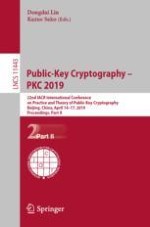2019 | OriginalPaper | Chapter
Adaptively Single-Key Secure Constrained PRFs for \(\mathrm {NC}^1\)
Authors : Nuttapong Attrapadung, Takahiro Matsuda, Ryo Nishimaki, Shota Yamada, Takashi Yamakawa
Published in: Public-Key Cryptography – PKC 2019
Publisher: Springer International Publishing
Activate our intelligent search to find suitable subject content or patents.
Select sections of text to find matching patents with Artificial Intelligence. powered by
Select sections of text to find additional relevant content using AI-assisted search. powered by











